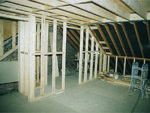Man is a builder. From the earliest points in history we have sought to construct shelter where there is none and improve the shelter when there is.

There is a tool for every job in the building Industry and the right tool makes the job easier
Building homes and providing shelter is as much a priority today as it was for the caveman, the only thing that’s has changed are the materials and tools we use. We dig and concrete foundations now, historically we simply built on rack. We build walls from bricks and block, before we used stone, word and mud. We have living rooms, dining rooms, kitchens, bedroom and bathrooms now; previously we ha a giant cave. We use clay, slate and concrete for roof tiles but before that, reeds and straw.
We search for materials which will allow us to create the shapes we need and provide the house, homes and superstructures we seek to make. We use natural materials as often as possible such as stone, timber, clay, lime, gypsum etc. Where no natural material exists we made, invented, created, discovered or accidentally found different materials such as steel. Concrete, rubber, carbon fibre and plastic.
Victorian London, with its sewers and channels is a masterpiece of engineering while tunneling into the birds nest of wires, drain and cables to provide a new tube station, without cutting off the power supply to the city is little less than a miracle.
We have turned clay into bricks and blocks, we have found iron in rocks and turned it into steel. In turn we have steel into everything from scaffolding to skyscrapers.
The following pages show the variety of methods we use to construct our homes and work places.






